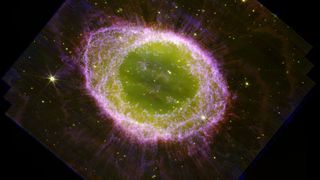The James Webb Space Telescope (JWST) has blessed us with yet another awe-inspiring image from space, capturing the vibrant Ring Nebula – which can be seen throughout August.
Also known as Messier 57, the eye-shaped nebula is found in the Lyra constellation 2,283 light years from Earth. The stunning purple and green photograph, taken by the NASA telescope, offers an extremely detailed look at the colorful glowing gas that gives the Ring Nebula its form. Made up of remnants of dying stars, it has been the center of amazement for night-sky enthusiasts since it was discovered in 1779 by the French astronomer, Augustin Darquier.
• Check out the best cameras for astrophotography
These latest images, analyzed by a team of astronomers led by Professor Mike Barlow of University College London and Dr Nick Cox of ACRI in France, offer more than just a breathtaking glimpse into the intricate design of this celestial wonder. For the first time ever, scientists have been able to develop a better understanding of how this cosmic phenomenon came to be, and view individual elements that make up this mesmerizing nebula.
Although confusingly named a planetary nebula, it has nothing to do with planets. When stars die they go through several stages before becoming a white dwarf and, in their final stages, beautiful gaseous clumps emit light in a specific color, depending on its chemical composition – much like a firework.
As stunning as these photos are, they also give us a glimpse into the future of our sun – which will undergo the same fate in around five billion years time. All stars will eventually run out of hydrogen gas and die, causing them to expel a mass of gas and dust into space, but the size and density of a star dictate how monumental the occurrence will be.
"The James Webb Space Telescope has provided us with an extraordinary view of the Ring Nebula that we've never seen before," explains Dr Nick Cox.

"These images hold more than just aesthetic appeal; they provide a wealth of scientific insights into the processes of stellar evolution. By studying the Ring Nebula with JWST, we hope to gain a deeper understanding of the life cycles of stars and the elements they release into the cosmos."
Since the telescope was sent into orbit in December 2021, it has continued to provide us with images that unlock secrets of the universe. From glowing nebulae to distant galaxies and comets formed with trails of water vapor, its advanced image-capturing devices have been paramount in developing a better understanding of the cosmos and what its future may hold.
If you loved this, check out the best lenses for astrophotography and the best telescopes for astrophotography and stargazing.


